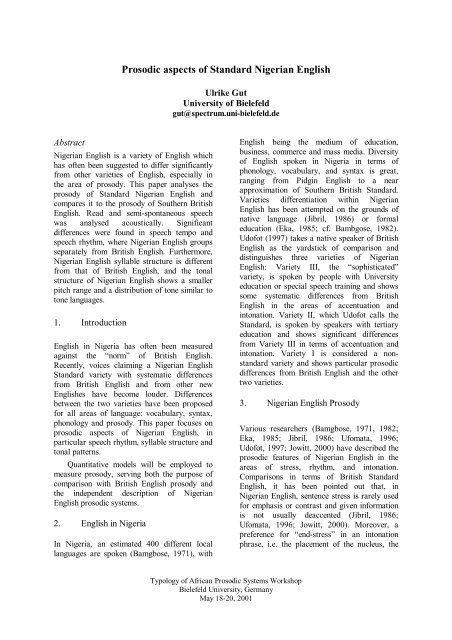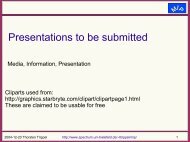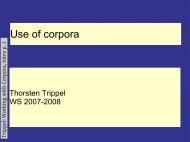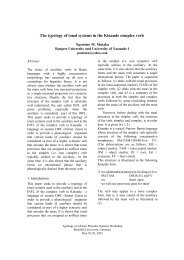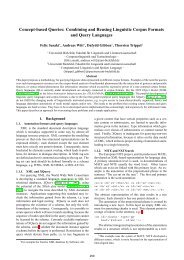Prosodic aspects of Standard Nigerian English - Computational ...
Prosodic aspects of Standard Nigerian English - Computational ...
Prosodic aspects of Standard Nigerian English - Computational ...
Create successful ePaper yourself
Turn your PDF publications into a flip-book with our unique Google optimized e-Paper software.
<strong>Prosodic</strong> <strong>aspects</strong> <strong>of</strong> <strong>Standard</strong> <strong>Nigerian</strong> <strong>English</strong><br />
Ulrike Gut<br />
University <strong>of</strong> Bielefeld<br />
gut@spectrum.uni-bielefeld.de<br />
Abstract<br />
<strong>Nigerian</strong> <strong>English</strong> is a variety <strong>of</strong> <strong>English</strong> which<br />
has <strong>of</strong>ten been suggested to differ significantly<br />
from other varieties <strong>of</strong> <strong>English</strong>, especially in<br />
the area <strong>of</strong> prosody. This paper analyses the<br />
prosody <strong>of</strong> <strong>Standard</strong> <strong>Nigerian</strong> <strong>English</strong> and<br />
compares it to the prosody <strong>of</strong> Southern British<br />
<strong>English</strong>. Read and semi-spontaneous speech<br />
was analysed acoustically. Significant<br />
differences were found in speech tempo and<br />
speech rhythm, where <strong>Nigerian</strong> <strong>English</strong> groups<br />
separately from British <strong>English</strong>. Furthermore,<br />
<strong>Nigerian</strong> <strong>English</strong> syllable structure is different<br />
from that <strong>of</strong> British <strong>English</strong>, and the tonal<br />
structure <strong>of</strong> <strong>Nigerian</strong> <strong>English</strong> shows a smaller<br />
pitch range and a distribution <strong>of</strong> tone similar to<br />
tone languages.<br />
1. Introduction<br />
<strong>English</strong> in Nigeria has <strong>of</strong>ten been measured<br />
against the “norm” <strong>of</strong> British <strong>English</strong>.<br />
Recently, voices claiming a <strong>Nigerian</strong> <strong>English</strong><br />
<strong>Standard</strong> variety with systematic differences<br />
from British <strong>English</strong> and from other new<br />
<strong>English</strong>es have become louder. Differences<br />
between the two varieties have been proposed<br />
for all areas <strong>of</strong> language: vocabulary, syntax,<br />
phonology and prosody. This paper focuses on<br />
prosodic <strong>aspects</strong> <strong>of</strong> <strong>Nigerian</strong> <strong>English</strong>, in<br />
particular speech rhythm, syllable structure and<br />
tonal patterns.<br />
Quantitative models will be employed to<br />
measure prosody, serving both the purpose <strong>of</strong><br />
comparison with British <strong>English</strong> prosody and<br />
the independent description <strong>of</strong> <strong>Nigerian</strong><br />
<strong>English</strong> prosodic systems.<br />
2. <strong>English</strong> in Nigeria<br />
In Nigeria, an estimated 400 different local<br />
languages are spoken (Bamgbose, 1971), with<br />
<strong>English</strong> being the medium <strong>of</strong> education,<br />
business, commerce and mass media. Diversity<br />
<strong>of</strong> <strong>English</strong> spoken in Nigeria in terms <strong>of</strong><br />
phonology, vocabulary, and syntax is great,<br />
ranging from Pidgin <strong>English</strong> to a near<br />
approximation <strong>of</strong> Southern British <strong>Standard</strong>.<br />
Varieties differentiation within <strong>Nigerian</strong><br />
<strong>English</strong> has been attempted on the grounds <strong>of</strong><br />
native language (Jibril, 1986) or formal<br />
education (Eka, 1985; cf. Bambgose, 1982).<br />
Ud<strong>of</strong>ot (1997) takes a native speaker <strong>of</strong> British<br />
<strong>English</strong> as the yardstick <strong>of</strong> comparison and<br />
distinguishes three varieties <strong>of</strong> <strong>Nigerian</strong><br />
<strong>English</strong>: Variety III, the “sophisticated”<br />
variety, is spoken by people with University<br />
education or special speech training and shows<br />
some systematic differences from British<br />
<strong>English</strong> in the areas <strong>of</strong> accentuation and<br />
intonation. Variety II, which Ud<strong>of</strong>ot calls the<br />
<strong>Standard</strong>, is spoken by speakers with tertiary<br />
education and shows significant differences<br />
from Variety III in terms <strong>of</strong> accentuation and<br />
intonation. Variety I is considered a nonstandard<br />
variety and shows particular prosodic<br />
differences from British <strong>English</strong> and the other<br />
two varieties.<br />
3. <strong>Nigerian</strong> <strong>English</strong> Prosody<br />
Various researchers (Bamgbose, 1971, 1982;<br />
Eka, 1985; Jibril, 1986; Ufomata, 1996;<br />
Ud<strong>of</strong>ot, 1997; Jowitt, 2000) have described the<br />
prosodic features <strong>of</strong> <strong>Nigerian</strong> <strong>English</strong> in the<br />
areas <strong>of</strong> stress, rhythm, and intonation.<br />
Comparisons in terms <strong>of</strong> British <strong>Standard</strong><br />
<strong>English</strong>, it has been pointed out that, in<br />
<strong>Nigerian</strong> <strong>English</strong>, sentence stress is rarely used<br />
for emphasis or contrast and given information<br />
is not usually deaccented (Jibril, 1986;<br />
Ufomata, 1996; Jowitt, 2000). Moreover, a<br />
preference for “end-stress” in an intonation<br />
phrase, i.e. the placement <strong>of</strong> the nucleus, the<br />
Typology <strong>of</strong> African <strong>Prosodic</strong> Systems Workshop<br />
Bielefeld University, Germany<br />
May 18-20, 2001
TAPS Proceedings<br />
Gut<br />
greatest stress, on the last word has been<br />
observed. In the dialogue (1) for example<br />
(1a) Come on who’ll volunteer.<br />
(1b) I will, if you insist.<br />
British <strong>English</strong> speakers put a nucleus on “I” in<br />
(1b), whereas <strong>Nigerian</strong> <strong>English</strong> speakers stress<br />
“will” most. In general, in <strong>Nigerian</strong> <strong>English</strong><br />
many lexical items can receive stress that do<br />
not usually do so in British <strong>English</strong> (Eka,<br />
1985). Ud<strong>of</strong>ot (1997) found that, when reading<br />
a passage <strong>of</strong> 143 syllables, <strong>Nigerian</strong> <strong>English</strong><br />
speakers accentuated between 63 and 121<br />
syllables whereas the British <strong>English</strong> control<br />
had accentuated 61. In spontaneous speech,<br />
differences between British and <strong>Nigerian</strong><br />
<strong>English</strong> were even more pronounced. The<br />
number <strong>of</strong> extra accented syllables ranged<br />
from 5 to 33 in the Variety III group, from 7 to<br />
34 in Variety II and from 15 to 90 in Variety I.<br />
This propensity to stress more syllables in<br />
<strong>Nigerian</strong> <strong>English</strong> than in British <strong>English</strong><br />
clearly contributes to the impression <strong>of</strong><br />
differences in speech rhythm between the two<br />
varieties <strong>of</strong> <strong>English</strong>. It has been suggested that<br />
<strong>Nigerian</strong> <strong>English</strong> has a syllable-timed rather<br />
than stress-timed rhythm (Bambgose, 1982; cf.<br />
Ud<strong>of</strong>ot, 1997). The languages <strong>of</strong> the world<br />
have traditionally been divided into stresstimed<br />
and syllable-timed (Pike, 1945;<br />
Abercrombie, 1967) where rhythm is<br />
understood to be a periodic recurrence <strong>of</strong><br />
events. In stress-timed languages these<br />
recurring events are stress beats and in<br />
syllable-timed languages syllables.<br />
Abercrombie (1967) proposes that in syllabletimed<br />
languages “chest-pulses, and hence the<br />
syllables, recur at equal intervals <strong>of</strong> time – they<br />
are isochronous” (p. 97). Syllables are assumed<br />
to be equal in length (p. 98), stress-pulses, on<br />
the other hand, are unevenly spaced.<br />
Abercrombie cites Yoruba, a <strong>Nigerian</strong><br />
language, as an example for a syllable-timed<br />
language. Stress-timed languages such as<br />
<strong>English</strong>, in contrast, are supposed to have<br />
regular recurring stress beats. Since the<br />
number <strong>of</strong> syllables between two stress beats<br />
varies, their length is adjusted to fit into the<br />
stress interval – syllable length, hence is very<br />
variable in stress-timed languages.<br />
One proposed reason for <strong>Nigerian</strong> <strong>English</strong><br />
being more syllable-timed than British <strong>English</strong><br />
is that vowel reduction is less pronounced,<br />
which leads to a perceptual impression <strong>of</strong> more<br />
equal weight and length <strong>of</strong> each syllable.<br />
Ud<strong>of</strong>ot (1997) measured the duration <strong>of</strong><br />
syllables in one read sentence and found that<br />
syllables containing reduced vowels were, on<br />
average, considerably longer in <strong>Nigerian</strong><br />
<strong>English</strong> than in British <strong>English</strong>. The duration<br />
<strong>of</strong> a single schwa for example is almost double<br />
as long in <strong>Nigerian</strong> <strong>English</strong> than in British<br />
<strong>English</strong>. In accented syllables, those containing<br />
long vowels such as [i] were longer in British<br />
<strong>English</strong> and those containing short vowels such<br />
as [I] were shorter in British <strong>English</strong> than in<br />
<strong>Nigerian</strong> <strong>English</strong>. Thus, syllable durations<br />
across all syllable structures and phonetic types<br />
are more similar in <strong>Nigerian</strong> <strong>English</strong> than in<br />
British <strong>English</strong>. The overall speech tempo was<br />
faster for the British control than for the<br />
<strong>Nigerian</strong> <strong>English</strong> speakers; pauses between<br />
intonation groups, however, were shorter in<br />
<strong>Nigerian</strong> <strong>English</strong> than in British <strong>English</strong>. In<br />
general, <strong>Nigerian</strong> <strong>English</strong> speakers divided<br />
their utterances into more intonation phrases<br />
than the British <strong>English</strong> speaker.<br />
In the area <strong>of</strong> intonation, equally,<br />
systematic differences between <strong>Nigerian</strong><br />
<strong>English</strong> and British <strong>English</strong> have been<br />
described. Jowitt (2000) analysed the<br />
intonation <strong>of</strong> 30 dialogues read aloud by<br />
<strong>Nigerian</strong> final-year undergraduates. It was<br />
transcribed in the system used by O’Connor &<br />
Arnold (1973) for British <strong>English</strong>: The basic<br />
unit <strong>of</strong> analysis is the “tone”, a specific pitch<br />
movement on a stressed syllable. The last<br />
stressed syllable in an utterance, which usually<br />
carries the main stress and a distinctive pitch<br />
movement, is called the nucleus. Nuclear types<br />
that are usually described for <strong>English</strong> include<br />
simple nuclei such as falls, rises and a level<br />
terminal pitch contour, complex nuclei include<br />
fall-rises, rise-falls and rise-fall-rises. The<br />
stretch from any stressed syllables preceding<br />
the nucleus up to the nucleus constitutes the<br />
head. Simple, multiple and compound heads<br />
are possible in <strong>English</strong>. Simple heads can have<br />
a falling, rising or level form. Multiple heads<br />
consist <strong>of</strong> a sequence <strong>of</strong> identical stressed<br />
syllables, e.g. three falling ones in a row.<br />
Compound heads contain a sequence <strong>of</strong><br />
different tones on stressed syllables. Any<br />
unstressed syllables preceding the head - or the<br />
nucleus if there is no head - are called<br />
“prehead”. They can be either low or high,<br />
with low being the neutral and high the marked
TAPS Proceedings<br />
Gut<br />
form. Only a high prehead receives a symbol,<br />
the ↑. Any stressed syllables following the<br />
nucleus are called the “tail”.<br />
Jowitt (2000) proposes the following<br />
characteristics <strong>of</strong> the <strong>Nigerian</strong> <strong>English</strong><br />
intonation system:<br />
- predominance <strong>of</strong> falling nuclei in statements,<br />
wh-questions and commands<br />
- predominance <strong>of</strong> rising nuclei in yes-no<br />
questions and tag questions<br />
- rare productions <strong>of</strong> complex nuclei<br />
- high pitch on lexical words<br />
Furthermore, he describes a “core pattern” <strong>of</strong><br />
<strong>Nigerian</strong> <strong>English</strong> heads, which is an initial high<br />
pitch followed by a downdrift.<br />
Ud<strong>of</strong>ot’s (1997) study presents similar<br />
results. She described <strong>Nigerian</strong> <strong>English</strong><br />
intonation using Pierrehumbert’s (1980)<br />
transcription system. Intonational analysis<br />
within this approach postulates three kinds <strong>of</strong><br />
discrete events that make up the pitch contour<br />
<strong>of</strong> an <strong>English</strong> utterance: Pitch accents, phrase<br />
accents and boundary tones. Pitch accents are<br />
characteristic pitch movements which are<br />
associated with prominent syllables. Phrase<br />
accents occur at the end <strong>of</strong> phrases, and<br />
boundary tones at the end <strong>of</strong> utterances. Two<br />
levels <strong>of</strong> tones are proposed, high (H) and low<br />
(L), which are the basic constituents <strong>of</strong> all<br />
accents and boundary tones.<br />
Ud<strong>of</strong>ot’s study revealed that, both in read<br />
and spontaneous speech, falling tones were<br />
predominant in <strong>Nigerian</strong> <strong>English</strong> (about 80%),<br />
rising tones relatively rare (about 10%) and<br />
fall-rises even rarer (about 9%), whereas risefalling<br />
tones were only produced by Variety III<br />
speakers. Compared to the British <strong>English</strong><br />
control, bi-directional tones (fall-rise) were<br />
produced significantly less in <strong>Nigerian</strong> <strong>English</strong><br />
(9% compared to 32%). Furthermore, the pitch<br />
range across an utterance is smaller in <strong>Nigerian</strong><br />
<strong>English</strong> than in British <strong>English</strong>. An acoustic<br />
analysis <strong>of</strong> the pitch movement in an utterance<br />
showed that, although <strong>Nigerian</strong> <strong>English</strong><br />
speakers spoke on a higher average pitch than<br />
the British control did, the difference between<br />
pitch peaks and pitch valleys was less<br />
pronounced.<br />
Very similar results were obtained by Eka<br />
(1985), who described <strong>Nigerian</strong> <strong>English</strong><br />
intonation using a parametric model adapted<br />
from Crystal (1969). He found a distribution <strong>of</strong><br />
93.3% simple tones and 6.6% complex tones in<br />
read <strong>Nigerian</strong> <strong>English</strong>, compared to 22%<br />
complex tones in a British <strong>English</strong> control<br />
speaker. Moreover, the pitch range was smaller<br />
in the <strong>Nigerian</strong> speakers than the British<br />
speaker.<br />
From impressionistic accounts it has been<br />
suggested that <strong>Nigerian</strong> <strong>English</strong> intonation<br />
reflects the prosodic structure <strong>of</strong> the speaker’s<br />
native language in a way that stressed syllables<br />
are associated with a high tone and unstressed<br />
syllables with a low tone (Wells, 1982). In<br />
fact, proposals have been made to treat<br />
<strong>Nigerian</strong> <strong>English</strong> as a tone language with tone<br />
on every syllable. In that case, intonation<br />
transcription with systems developed for the<br />
prosody <strong>of</strong> intonation languages such as British<br />
<strong>English</strong> cannot capture the tonal structure <strong>of</strong><br />
<strong>Nigerian</strong> <strong>English</strong>.<br />
4. Aims <strong>of</strong> the study<br />
The aim <strong>of</strong> the study is a description <strong>of</strong><br />
<strong>Nigerian</strong> <strong>English</strong> prosody. First, the rhythm <strong>of</strong><br />
<strong>Nigerian</strong> <strong>English</strong> will be explored using a<br />
measurement based on durational variability <strong>of</strong><br />
subsequent syllables and vowels. In addition,<br />
phrasing and syllabification in both read<br />
speech and semi-spontaneous speech will be<br />
investigated. The results will be compared to<br />
the speech <strong>of</strong> a British <strong>English</strong> speaker.<br />
Second, the tonal structure <strong>of</strong> <strong>Nigerian</strong> <strong>English</strong><br />
will be explored without the presumption that<br />
description systems developed for intonation<br />
languages can be applied without alteration.<br />
Instead, the pitch height <strong>of</strong> each syllable will<br />
be labelled in order to arrive at a phonetic<br />
description <strong>of</strong> the intonation <strong>of</strong> <strong>Nigerian</strong><br />
<strong>English</strong>. In addition, the pitch range <strong>of</strong> the<br />
utterances in the read speech will be measured.<br />
5. Method<br />
5.1 Participants<br />
Five speakers <strong>of</strong> <strong>Nigerian</strong> <strong>English</strong>, four female<br />
and one male, were recorded. The participants<br />
were chosen as speakers <strong>of</strong> <strong>Nigerian</strong> <strong>English</strong><br />
<strong>Standard</strong> on the grounds <strong>of</strong> their education and<br />
linguistic history. All were born and educated
TAPS Proceedings<br />
Gut<br />
in Nigeria and hold university degrees.<br />
Although five <strong>of</strong> them are presently engaged in<br />
studies or research in Germany, none <strong>of</strong> them<br />
spent any extended period <strong>of</strong> time in any<br />
<strong>English</strong> speaking country other than Nigeria.<br />
Table 1 lists the linguistic background <strong>of</strong> all<br />
participants. Speaker E teaches in a <strong>Nigerian</strong><br />
university and is currently living in Germany.<br />
She speaks Ibibio, Efik, <strong>English</strong>, some Igbo,<br />
and some Yoruba. Speaker I, teaches in a<br />
<strong>Nigerian</strong> university and is presently studying<br />
for a Ph.D in Germany. She speaks Igbo<br />
(mother tongue), <strong>English</strong> and German. Speaker<br />
G was born in Nigera <strong>of</strong> Efik parentage, did all<br />
her studies from primary to the Bachelor’s<br />
degree in Nigeria and is presently studying for<br />
her Master’s degree in Germany. She speaks<br />
Efik (mother tongue), <strong>English</strong> and German.<br />
Speaker B is a University teacher in Nigeria<br />
and does translation work from Edo into<br />
<strong>English</strong> and from <strong>English</strong> into Edo. She speaks<br />
Edo (mother tongue), Yoruba, and <strong>English</strong>.<br />
Speaker J did all studies from primary to first<br />
degree in Nigeria and is presently studying in<br />
Germany. He speaks Yoruba, <strong>English</strong> and<br />
German.<br />
speaker sex<br />
Speaker’s native language<br />
native tonal syllabic<br />
language structure structure<br />
V, N, CV,<br />
CVV,<br />
CVC,<br />
CVVC,<br />
CCV<br />
E female Ibibio H L !H<br />
HL LH<br />
I female Igbo H L !H V, N, CV,<br />
CVN<br />
G female Efik H L !H V, N, CV,<br />
CVC,<br />
CCV<br />
B female Edo H L !H V, N, CV<br />
!L<br />
J male Yoruba H M L V, N, CV<br />
Table 1 : The <strong>Nigerian</strong> participants and their<br />
language background<br />
In addition, two male and one female speaker<br />
<strong>of</strong> British <strong>English</strong> were recorded. They were<br />
all born and educated in Great Britain and hold<br />
British University degrees.<br />
5.2 Data<br />
All participants read a story <strong>of</strong> 268 words for<br />
which they had as much time for preparation as<br />
they wanted. Subsequently, they were asked to<br />
retell the story in their own words. If they had<br />
difficulty with this they were encouraged to<br />
imagine telling the story to a child. <strong>Nigerian</strong><br />
<strong>English</strong> speaker B did not do a retelling <strong>of</strong> the<br />
story.<br />
5.3 Analysis<br />
The data were analysed using ESPS/waves+.<br />
All syllables were transcribed phonetically in<br />
SAMPA and then converted into syllabic types<br />
where vowels were coded as V and stops,<br />
fricatives, liquids, nasals, glides, implosives<br />
and approximants were coded as C. The<br />
transcription reflects resyllabification<br />
processes present in the actual spontaneous<br />
speech. For the measurement <strong>of</strong> speech<br />
rhythm, phrasing and durational <strong>aspects</strong> were<br />
calculated. First, the read story and the<br />
retellings were divided into phrases by taking a<br />
pause to signal the end <strong>of</strong> a phrase. Pauses that<br />
preceded repairs were not considered to<br />
indicate phrasal boundaries and the<br />
reparandum, i.e. the to-be-repaired words,<br />
were not counted as a phrase.<br />
Second, the length <strong>of</strong> each vocalic and<br />
consonantal interval was measured. Only the<br />
stable formant structure <strong>of</strong> vowels was<br />
included in the vocalic parts. Following Ramus<br />
et al. (1999), the proportion <strong>of</strong> vocalic intervals<br />
across all speech (%V) and the standard<br />
deviation <strong>of</strong> the length <strong>of</strong> the consonantal<br />
intervals (delta C) was calculated.<br />
In order to test the assumption <strong>of</strong> syllabletiming<br />
in <strong>Nigerian</strong> <strong>English</strong>, the relationship<br />
between subsequent syllables in 10 read<br />
sentences <strong>of</strong> the story produced by the British<br />
<strong>English</strong> and the <strong>Nigerian</strong> <strong>English</strong> speakers<br />
were compared with the Rhythm Ratio (RR).<br />
The Rhythm Ratio (Gibbon & Gut, 2001) is<br />
based on the following formula:<br />
RR = 100<br />
m<br />
∑ − 1<br />
k=<br />
1<br />
di<br />
/<br />
dj<br />
( m − 1)<br />
where d i =d k and d j =d k+1 if d i is smaller than d j<br />
and d j =d k and d i = dk+1 if d i is not smaller than d j .<br />
In other words, for each pair <strong>of</strong> adjacent<br />
syllables, the shorter is divided by the longer.<br />
The average <strong>of</strong> all these ratios is calculated and<br />
multiplied by 100. Thus, if the RR equals 100<br />
subsequent syllables have exactly the same
TAPS Proceedings<br />
Gut<br />
duration. The lower the degree <strong>of</strong> similarity the<br />
lower the RR value.<br />
The tonal structure <strong>of</strong> <strong>Nigerian</strong> <strong>English</strong> was<br />
transcribed using a ToBI-style (Silverman et<br />
al., 1992) system. The pitch or pitch movement<br />
<strong>of</strong> each syllable was marked as either high,<br />
low, mid, falling or rising according to the<br />
following conventions:<br />
H<br />
L<br />
M<br />
HL<br />
LH<br />
low level<br />
high level<br />
mid level<br />
falling<br />
rising<br />
Transcription was based on a combination <strong>of</strong><br />
instrumental analysis in the form <strong>of</strong> the<br />
automatically calculated pitch contour and an<br />
auditory verification. None <strong>of</strong> the labels have<br />
phonological status but reflect only phonetic<br />
tones.<br />
In addition, the pitch range <strong>of</strong> all speakers<br />
was calculated. The value <strong>of</strong> initial high pitch,<br />
<strong>of</strong> the final low pitch and intervening peaks<br />
and valleys for each utterance were annotated.<br />
The maximal pitch range was determined by<br />
subtracting the mean value <strong>of</strong> the final low<br />
from the mean value <strong>of</strong> the initial high pitch<br />
and the small pitch range was calculated by<br />
subtracting the mean value <strong>of</strong> the valleys from<br />
the mean value <strong>of</strong> the peaks. All calculations<br />
were carried out automatically, using the<br />
TASX environment (Milde & Gut, 2001,<br />
2002).<br />
Accents produced by all speakers in the<br />
read story were marked by four trained<br />
phoneticians (all native speakers <strong>of</strong> German).<br />
No difference was made between primary and<br />
secondary stress. Agreement among raters<br />
(number <strong>of</strong> accents marked by all raters<br />
divided by number <strong>of</strong> accents marked by at<br />
least one rater) is 49.6 % for the British<br />
<strong>English</strong> speakers and 59 % for the <strong>Nigerian</strong><br />
<strong>English</strong> speakers.<br />
the average length <strong>of</strong> phrases in semispontaneous<br />
speech. The British <strong>English</strong><br />
speakers divided the story into 36 to 41<br />
phrases, the <strong>Nigerian</strong> <strong>English</strong> speakers<br />
produced between 43 and 52 phrases in the<br />
same text. The average length <strong>of</strong> a phrase<br />
ranges between 7.15 and 13.3 words for the<br />
British <strong>English</strong> speakers and ranges between<br />
7.2 and 5.9 for the <strong>Nigerian</strong> <strong>English</strong> speakers.<br />
In semi-spontaneous speech, British <strong>English</strong><br />
speaker H produces, on average, considerably<br />
more words per phrase than any other speaker<br />
and more than when reading the story aloud.<br />
All other speakers produce, on average, shorter<br />
phrases in semi-spontaneous speech than in<br />
read speech.<br />
Speaker<br />
D (British<br />
<strong>English</strong>)<br />
A (British<br />
<strong>English</strong>)<br />
H (British<br />
<strong>English</strong>)<br />
Number<br />
<strong>of</strong> phrases<br />
in the read<br />
text<br />
Average<br />
length <strong>of</strong><br />
phrase in<br />
read text<br />
40 7.3 6.7<br />
41 7.15 8.3<br />
36 13.3 16.8<br />
G (Efik) 43 7.1 8.9<br />
E (Ibibio) 43 7 6.2<br />
I (Igbo) 44 7.2 6.4<br />
B (Edo) 49 6.5 --<br />
J (Yoruba) 52 5.9 4.8<br />
Average<br />
length <strong>of</strong><br />
phrase in<br />
semispontaneous<br />
speech<br />
Table 2. Number <strong>of</strong> pauses produced in the read text by<br />
all speakers, the average length <strong>of</strong> each phrase (in<br />
words) and the average length <strong>of</strong> phrases in semispontaneous<br />
speech.<br />
Figure 1 illustrates that <strong>Nigerian</strong> <strong>English</strong><br />
speech rhythm (N), measured in the acoustic<br />
variables %V and delta C, groups distinctly<br />
from the speech rhythm <strong>of</strong> British <strong>English</strong><br />
(BE).<br />
6. Results<br />
6.1 Rhythm<br />
Table 2 presents the number <strong>of</strong> pauses<br />
produced in the read text by all speakers, the<br />
average length <strong>of</strong> each phrase (in words) and
TAPS Proceedings<br />
Gut<br />
syllables than closed syllables. For the other<br />
<strong>Nigerian</strong> speakers, the reverse is true (see<br />
Table 4).<br />
Figure 1: Speech rhythm <strong>of</strong> the <strong>Nigerian</strong> <strong>English</strong><br />
(N)speakers (read and re-telling) compared to<br />
the British <strong>English</strong> (BE) (read and re-telling)<br />
speakers.<br />
The overall percentage <strong>of</strong> vowels in <strong>Nigerian</strong><br />
<strong>English</strong> is higher than in British <strong>English</strong>.<br />
Equally, delta C in <strong>Nigerian</strong> <strong>English</strong> is higher<br />
than that in British <strong>English</strong>.<br />
Table 3 lists the percentage <strong>of</strong> the most<br />
frequent syllable types occurring in the read<br />
speech <strong>of</strong> all speakers. Compared to the British<br />
speakers, all <strong>Nigerian</strong> speakers except for<br />
speaker NE2 produce a higher percentage <strong>of</strong><br />
CV syllables in the read story. In general,<br />
individual differences between the<br />
syllabification <strong>of</strong> the story are evident among<br />
the <strong>Nigerian</strong> speakers. Whereas <strong>Nigerian</strong><br />
speaker NE2 is very similar to the British<br />
<strong>English</strong> speakers, the other <strong>Nigerian</strong> speakers<br />
differ from them.<br />
Speaker CV CVC VC CVV V CVVC<br />
D 28 19 11.7 7.9 5.7 5.3<br />
A 24.5 18.5 11.1 7.3 6.6 4.5<br />
H 23.5 22.1 11.2 4.6 3.8 2.4<br />
G 36.5 20.7 12 5.5 8 3<br />
E 28 20 15 6 5 4.5<br />
I 37.5 16 10.6 6 8 5<br />
B 40 19.5 10 4.7 8 3<br />
J 36 17 12.5 5 8 4<br />
Table 3: Percentages <strong>of</strong> the most frequent syllable types<br />
produced by each British and <strong>Nigerian</strong> <strong>English</strong> spe aker<br />
in the read speech.<br />
Looking at the percentage <strong>of</strong> open and closed<br />
syllables in the speech <strong>of</strong> each speaker it can<br />
be seen that the British <strong>English</strong> speakers and<br />
<strong>Nigerian</strong> speaker NE2 produce fewer open<br />
Open syllables Closed<br />
syllables<br />
D 44.7 55.2 315<br />
A 38.4 61.6 286<br />
H 31.8 68.1 295<br />
G 53.3 46.4 309<br />
E 42.1 57.8 330<br />
I 53.9 46 330<br />
B 55.5 44.4 317<br />
J 52.9 47 319<br />
Number <strong>of</strong><br />
syllables<br />
Table 4: Percentages <strong>of</strong> open and closed<br />
syllables produced by each British and <strong>Nigerian</strong><br />
<strong>English</strong> speaker in the read speech.<br />
6.2 Tone<br />
Figure 2 shows the percentages <strong>of</strong> level tones<br />
and contour tones on all syllables in both the<br />
read speech and the semi-spontaneous speech<br />
across all <strong>Nigerian</strong> <strong>English</strong> speakers. Contour<br />
tones or pitch movements on a syllable are<br />
very rare in <strong>Nigerian</strong> <strong>English</strong>. Between 92%<br />
and 98.5% <strong>of</strong> all syllables have a level tone.<br />
No differences between read speech and semispontaneous<br />
speech were found. The<br />
distribution <strong>of</strong> contour tones is highly<br />
restricted. Pitch movements on syllables occur<br />
predominately in pre-pausal syllables. This is<br />
the case for 82% <strong>of</strong> all pitch movements<br />
produced by speaker J, for 91% produced by<br />
speaker G, for 96% produced by speaker I,<br />
75% produced by speaker B and 100% <strong>of</strong> all<br />
pitch movements produced by speaker E.<br />
100<br />
80<br />
60<br />
40<br />
20<br />
0<br />
G E I B J<br />
level tone<br />
contour tone<br />
Figure 2: Percentages <strong>of</strong> level tones and contour<br />
tones in <strong>Nigerian</strong> <strong>English</strong> read and semispontaneous<br />
speech.<br />
Pitch height <strong>of</strong> syllables in <strong>Nigerian</strong> <strong>English</strong><br />
seems grammatically determined. The speakers
TAPS Proceedings<br />
Gut<br />
showed a tendency to associate different<br />
syntactic categories with particular tones.<br />
Articles, prepositions and conjunctions, for<br />
example, are always produced with a low or a<br />
mid tone. Verbs, adjectives and nouns, on the<br />
other hand, tend to be produced with a H.<br />
Table 5 illustrates this on the phrase « were<br />
walking in a field ».<br />
were wal king In a field<br />
G L M H L L HL<br />
E L H H L L H<br />
I L H H L L HL<br />
B L H H L L H<br />
J L H H L L HL<br />
Table 5: Pitch produced by the <strong>Nigerian</strong> <strong>English</strong><br />
speaker in the phrase “a tiger and a mouse”.<br />
However, not only the “stressed” syllable, the<br />
one that would be accented in British <strong>English</strong>,<br />
is associated with a high tone but all syllables<br />
<strong>of</strong> a multisyllabic word.<br />
Tables 6 and 7 present the tonal structure<br />
<strong>of</strong> some multisyllabic words that did not occur<br />
phrase-initially or phrase-finally in the read<br />
story produced by all <strong>Nigerian</strong> <strong>English</strong><br />
speakers.<br />
tiger walking lying somewhere<br />
G HH HH HH MM<br />
E HH HM HM HH<br />
I HM HH HH HL<br />
B HH HH LL LL<br />
J HH MM HH ML<br />
Table 6: Tonal patterns produced on multisyllabic<br />
words by the <strong>Nigerian</strong> <strong>English</strong> speakers.<br />
Despite inter-speaker differences, it can be<br />
seen that the syllables <strong>of</strong> a multisyllabic word<br />
are usually produced with equally (high) tone.<br />
“Tiger”, for example, has two high tones in the<br />
majority <strong>of</strong> the recorded productions. The<br />
same holds true for “walking”, “lying”, and<br />
“something”. These are all examples <strong>of</strong><br />
multisyllabic words with primary word stress<br />
on the first syllable. Words with primary stress<br />
on the second or even later syllable<br />
demonstrate another tonal pattern (Table 7):<br />
the first “unstressed” syllable usually carries a<br />
low tone, the “stressed” syllable carries a high<br />
tone, which is then continued throughout the<br />
rest <strong>of</strong> the word. Examples for this are the<br />
words “whatever”, “continued”, “remove”,<br />
“enough” and “began”. The data thus suggest a<br />
right-spreading rule for H on multisyllabic<br />
words, beginning with the first stressed<br />
syllable.<br />
Table 7: Tonal patterns produced on<br />
multisyllabic words by the <strong>Nigerian</strong> <strong>English</strong><br />
speakers.<br />
6.3 Pitch range<br />
remove continued enough began<br />
G LH LHH LH LH<br />
E LH LHH HM LH<br />
I LH MHM MM ML<br />
B MM LHH LH LM<br />
J LH LHH LH LM<br />
Pitch range is smaller for the <strong>Nigerian</strong> <strong>English</strong><br />
speakers than for the British <strong>English</strong> speakers.<br />
The maximal pitch range (initial high minus<br />
final low) for the British <strong>English</strong> speakers<br />
ranges between 12.3 and 15 semi-tones ; for<br />
the <strong>Nigerian</strong> <strong>English</strong> speakers it ranges<br />
from8.05 to 11.6 (see Table 8)<br />
Maximal pitch range<br />
D 12.3 6.7<br />
A 15 6.8<br />
H 14.9 6<br />
G 9 3.2<br />
E 8.05 2.98<br />
I 11.6 6.05<br />
B 9.6 2.1<br />
Small pitch range<br />
Table 8: Maximal and small pitch range <strong>of</strong> the<br />
British <strong>English</strong> and <strong>Nigerian</strong> <strong>English</strong> speakers (in<br />
semi-tones).<br />
The same holds true for the small pitch range,<br />
which was measured between utteranceinternal<br />
pitch peaks and valleys: except for<br />
speaker I, it is higher in British <strong>English</strong> than in<br />
<strong>Nigerian</strong> <strong>English</strong>.
TAPS Proceedings<br />
Gut<br />
6.4 Accent and stress<br />
Accents were marked when at least three out <strong>of</strong><br />
the four raters were in agreement. The number<br />
<strong>of</strong> accented syllables in the British <strong>English</strong> and<br />
the <strong>Nigerian</strong> <strong>English</strong> reading <strong>of</strong> the story is<br />
significantly lower (Table 9). An analysis <strong>of</strong><br />
the word categories which were produced with<br />
an accent revealed that <strong>of</strong> the 106 nouns, verbs<br />
and adjectives in the text, the British <strong>English</strong><br />
speakers accented 81, whereas the <strong>Nigerian</strong><br />
<strong>English</strong> speakers accented 98.<br />
mean number <strong>of</strong><br />
accents<br />
Table 9: Mean number <strong>of</strong> accented syllables<br />
produced by the British and the <strong>Nigerian</strong> speakers<br />
in the read story.<br />
The major difference in accent placement<br />
between the two groups was that in <strong>Nigerian</strong><br />
<strong>English</strong> nearly all sentence-final words<br />
received an accent (%), whereas this was only<br />
the case in % for the British <strong>English</strong> speakers.<br />
No systematic differences in word stress were<br />
found between <strong>Nigerian</strong> <strong>English</strong> and British<br />
<strong>English</strong>.<br />
7. Discussion<br />
British<br />
<strong>English</strong><br />
<strong>Nigerian</strong><br />
<strong>English</strong><br />
101 115.6<br />
range 90-103 103-129<br />
The results show distinct prosodic differences<br />
between the varieties <strong>of</strong> <strong>English</strong> spoken in<br />
Southern Britain and in Nigeria. In general,<br />
<strong>Nigerian</strong> speakers divide a text into more<br />
phrases than British <strong>English</strong> speakers and<br />
consequently produce fewer syllables per<br />
phrase. The latter is also true for spontaneous<br />
speech. These factors probably contribute to<br />
the auditory impression <strong>of</strong> slower speech rate<br />
in <strong>Nigerian</strong> <strong>English</strong> (Ud<strong>of</strong>ot, 1997).<br />
In terms <strong>of</strong> speech rhythm <strong>Nigerian</strong> <strong>English</strong> is<br />
different from the speech rhythm <strong>of</strong> British<br />
<strong>English</strong>. Especially the percentage <strong>of</strong> vowel<br />
intervals is greater in <strong>Nigerian</strong> <strong>English</strong> than in<br />
British <strong>English</strong>. Compared to other languages<br />
classified with Ramus et al.’s (1999)<br />
measurement <strong>of</strong> rhythm, <strong>Nigerian</strong> <strong>English</strong><br />
groups with Spanish, Catalan, Italian and<br />
French, all <strong>of</strong> which are presumed to be<br />
syllable-timed, in terms <strong>of</strong> the vowel<br />
percentage, but shows a higher standard<br />
deviation <strong>of</strong> consonantal intervals than those<br />
languages. Compared to other varieties <strong>of</strong><br />
<strong>English</strong>, <strong>Nigerian</strong> <strong>English</strong> speech rhythm is<br />
similar to that <strong>of</strong> Singapore <strong>English</strong> ins<strong>of</strong>ar as<br />
the %V is higher than in British <strong>English</strong>.<br />
Singapore <strong>English</strong>, however, shows a smaller<br />
delta C than <strong>Nigerian</strong> <strong>English</strong> (Grabe & Low,<br />
2001).<br />
Equally, syllabification is different in<br />
<strong>Nigerian</strong> <strong>English</strong> compared to British <strong>English</strong>.<br />
In the former, a higher percentage <strong>of</strong> CV<br />
syllables occurs and the ratio <strong>of</strong> open and<br />
closed syllables is different from that in British<br />
<strong>English</strong>. However, interindividual differences<br />
between the <strong>Nigerian</strong> <strong>English</strong> speakers become<br />
apparent.<br />
The transcription strategy for intonation<br />
revealed inter-individual differences between<br />
the <strong>Nigerian</strong> <strong>English</strong> speakers. Whereas it was<br />
very easy to assign tone to each syllable for<br />
three speakers, the intonation <strong>of</strong> some<br />
utterances by two other speaker could<br />
sometimes have been transcribed better with<br />
ToBI (Silverman et al., 1992) categories. There<br />
were cases where pitch was descending<br />
gradually over a series <strong>of</strong> syllables between a<br />
H and a L. The majority <strong>of</strong> <strong>Nigerian</strong> <strong>English</strong><br />
utterances, however, showed abrupt steps up or<br />
down between syllables and was therefore best<br />
transcribed by levels tones assigned to each<br />
syllable.<br />
The results <strong>of</strong> this study suggest that<br />
contour tones on syllables are very rare in<br />
<strong>Nigerian</strong> <strong>English</strong> and only occur in very<br />
restricted environments, mainly on pre-pausal<br />
syllables. A tendency to produce stressed<br />
syllables with a high tone and unstressed ones<br />
with a low tone, as proposed in Wells (1982),<br />
was not found. Rather, words <strong>of</strong> particular<br />
grammatical categories seem to be associated<br />
with specific tones. Articles, prepositions and<br />
conjunctions tend to have a low tone, whereas<br />
nouns, verbs and adjectives are usually<br />
produced with a high tone. A special rightspreading<br />
tone rule was found for multisyllabic<br />
verbs and nouns, where “unstressed” syllables<br />
are associated with a low tone and the<br />
“stressed” syllable and all other following ones<br />
have a high tone. <strong>Nigerian</strong> <strong>English</strong> prosody is<br />
thus close to those tone languages that have<br />
tones associated with a grammatical rather than
TAPS Proceedings<br />
Gut<br />
lexically contrastive function than to the use <strong>of</strong><br />
tone in intonation languages.<br />
Pitch range in read speech speech is<br />
smaller for the <strong>Nigerian</strong> <strong>English</strong> speakers than<br />
the British <strong>English</strong> speakers. Both the range<br />
between the extremes first high pitch and final<br />
low pitch and the range between the utternaceinternal<br />
peaks and valleys are considerably<br />
different. However, here again inter-individual<br />
differences among the <strong>Nigerian</strong> <strong>English</strong><br />
speakers are evident.<br />
Transcription <strong>of</strong> <strong>Nigerian</strong> <strong>English</strong><br />
intonation was done phonetically in this study,<br />
but the analysis supports a first tentative<br />
proposal <strong>of</strong> <strong>Nigerian</strong> <strong>English</strong> intonational<br />
phonology: Tone in <strong>Nigerian</strong> <strong>English</strong> is<br />
grammatically determined with lexical words<br />
receiving high tone from the first “stressed”<br />
syllable on and non-lexical words receiving<br />
low tone. Two tones are sufficient to describe<br />
<strong>Nigerian</strong> <strong>English</strong> intonation: H and L. There is<br />
initial raising, which causes intitial low tones<br />
to appear phonetically as a mid tone. Equally,<br />
downstep lowers high tones on the second and<br />
subsequent lexical words to a phonetic mid<br />
tone. <strong>Nigerian</strong> <strong>English</strong> has two boundary<br />
tones: H% and L%, which may combine with<br />
the level tones to form the contour tones HL<br />
and LH. A low boundary tone can suppress the<br />
H <strong>of</strong> a lexical word. This proposal now needs<br />
to be tested with a wider range <strong>of</strong> speech types<br />
and speakers.<br />
This study yielded inconclusive results<br />
regarding stress in <strong>Nigerian</strong> <strong>English</strong>. No<br />
differences in word stress were found, which is<br />
probably due to the simple vocabulary <strong>of</strong> the<br />
story. The raters found it easier to mark<br />
accents in <strong>Nigerian</strong> <strong>English</strong> than in British<br />
<strong>English</strong>, which might be explained by the facts<br />
that all syllables marked as accented in<br />
<strong>Nigerian</strong> <strong>English</strong> had a distinct high tone and<br />
that the speech tempo was slower in <strong>Nigerian</strong><br />
<strong>English</strong>. Raters identified more accents in the<br />
story read by the <strong>Nigerian</strong> <strong>English</strong> speaker<br />
than the British <strong>English</strong> speakers, which<br />
reflects the fact that nearly every lexical word<br />
was perceived as an accent. These results<br />
support Ud<strong>of</strong>ot’s (1997) findings, who also<br />
reported a higher rate <strong>of</strong> accentuation in<br />
<strong>Nigerian</strong> <strong>English</strong>.<br />
All these findings suggest that <strong>Nigerian</strong><br />
<strong>English</strong> prosody is typologically different from<br />
British <strong>English</strong> and stands “between” a stresstimed<br />
intonation language and a tone language.<br />
Tone plays a much more important role, has a<br />
grammatical function and is closely<br />
interrelated with accents and stress. The tone<br />
inventory is reduced in <strong>Nigerian</strong> <strong>English</strong><br />
compared to British <strong>English</strong>, but it is<br />
associated with every syllable.<br />
8. References<br />
Abercrombie, D. (1967). Elements <strong>of</strong> General<br />
Phonetics. Edinburgh: Edinburgh University<br />
Press.<br />
Bamgbose, A. (1971). The <strong>English</strong> Language<br />
in Nigeria. In: J. Spencer, The <strong>English</strong><br />
language in West Africa, London: Longman,<br />
pp. 35-48.<br />
Bamgbose, A. (1982). <strong>Standard</strong> <strong>Nigerian</strong><br />
<strong>English</strong>: Issues <strong>of</strong> Identification. In: B.<br />
Kachru (ed.), The other tongue. <strong>English</strong><br />
across cultures, Oxford: Pergamon Press,<br />
pp. 99-111.<br />
Crystal, D. (1969). <strong>Prosodic</strong> systems and<br />
intonation in <strong>English</strong>. Cambridge:<br />
Cambridge University Press.<br />
Eka, D. (1985). A Phonological Study <strong>of</strong><br />
<strong>Standard</strong> <strong>Nigerian</strong> <strong>English</strong>. Doctoral<br />
dissertation, Ahmadu Bello University,<br />
Zaria.<br />
Gibbon, D. & Gut, U. (2001). Measuring<br />
Speech Rhythm. Proceedings <strong>of</strong><br />
Eurospeech, Aalborg.<br />
Grabe, E. & Low, E.-L. (2001). Durational<br />
Variability in Speech and the Rhythm Class<br />
Hypothesis. Papers in Laboratory<br />
Phonology 8.<br />
Jibril, M. (1986). Sociolinguistic variation in<br />
<strong>Nigerian</strong> <strong>English</strong>. <strong>English</strong> World-Wide 7,<br />
147-174.<br />
Jowitt, D. (2000). Patterns <strong>of</strong> <strong>Nigerian</strong> <strong>English</strong><br />
Intonation. <strong>English</strong> World Wide 21:1, 63-80.<br />
Milde, J.-T. & Gut, U. (2001) The TASXenvironment:<br />
An XML-based corpus<br />
database for time-aligned language data.<br />
Proceedings <strong>of</strong> IRCS workshop <strong>of</strong> linguistic<br />
databases.<br />
Milde, J.-T. & Gut, U. (2002). A prosodic<br />
corpus <strong>of</strong> speech? Prosody 2002, Aix-en-<br />
Provence.<br />
O’Connor, J. & Arnold, G. (1973). Intonation<br />
<strong>of</strong> colloquial <strong>English</strong>. London: Longman.<br />
(2nd ed)<br />
Pierrehumbert, J. (1980). The phonology and<br />
phonetics <strong>of</strong> <strong>English</strong> intonation. Doctoral<br />
dissertation, Cambridge, Mass.: MIT.
TAPS Proceedings<br />
Gut<br />
Pike, K. (1945). The Intonation <strong>of</strong> American<br />
<strong>English</strong>. Ann Arbor: University <strong>of</strong> Michigan<br />
Press.<br />
Ramus, F., Nespor, M. & Mehler, J. (1999).<br />
Correlates <strong>of</strong> linguistic rhythm in the speech<br />
signal. Cognition, 73, 3: 265-292.<br />
Silverman, K., Beckman, M., Pitrelli, J.,<br />
Ostendorf, M., Wightman, C.,<br />
Pierrehumbert, J. & Hirschberg, J. (1992).<br />
“ToBI: a standard for labeling <strong>English</strong><br />
prosody”. Proceedings, Second<br />
International Conference on Spoken<br />
Language Processing 2, Banff, Canada, pp.<br />
867-70.<br />
Ud<strong>of</strong>ot, I. (1997). The rhythm <strong>of</strong> spoken<br />
<strong>Nigerian</strong> <strong>English</strong>. Doctoral Dissertation,<br />
University <strong>of</strong> Uyo, Nigeria.<br />
Ufomata, T. (1996). Setting Priorities in<br />
Teaching <strong>English</strong> Pronunciation in ESL<br />
Contexts.<br />
http://pitch.phon.ucl.ac.uk/home/shl9/ufoma<br />
ta/titi.<br />
Wells, J. (1982). Accents <strong>of</strong> <strong>English</strong>.<br />
Cambridge: Cambridge University Press.


